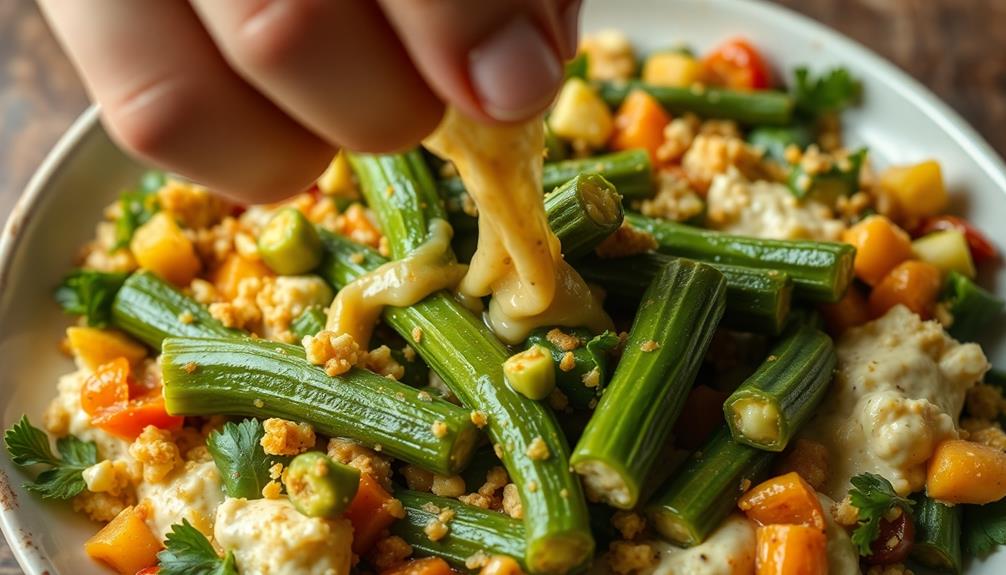You can't stand certain food textures because your brain processes sensory information differently. This sensitivity can lead to strong emotional reactions, making specific textures uncomfortable or even repulsive to you. Past negative experiences with these textures can also reinforce your aversions, affecting your food preferences over time. Cultural background plays a role too, influencing your openness to new textures. Understanding these factors, including stress and emotional ties, can help you navigate your dislikes. If you're curious about ways to manage these aversions or learn more about texture influences, there's plenty to explore further.
Key Takeaways
- Sensory processing disorder (SPD) can heighten sensitivities to food textures, leading to discomfort and aversions.
- Negative past experiences with certain textures reinforce long-term food preferences and aversions.
- Emotional associations with textures can evoke feelings of disgust or discomfort, influencing eating behaviors.
- Cultural backgrounds shape texture preferences, affecting openness to trying new foods and textures.
- Gradual exposure to disliked textures, paired with enjoyable flavors, can help manage and desensitize aversions.
Understanding Sensory Food Aversion
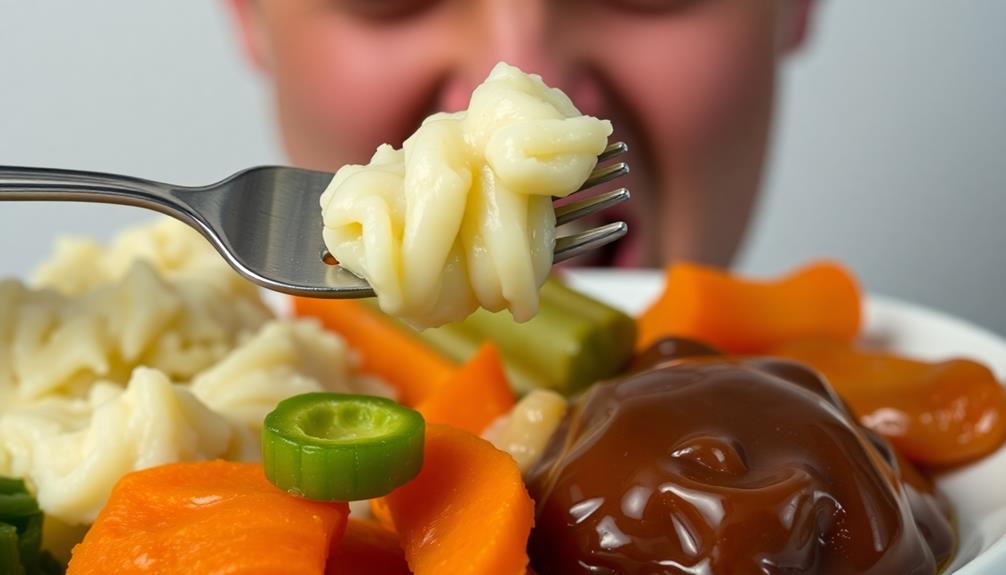
Sensory food aversion can feel like an overwhelming wall of discomfort when faced with certain textures. If you've ever gagged or felt repulsed by a particular food, you might be experiencing sensory food aversion. This condition often stems from sensory processing disorder (SPD), where your brain struggles to interpret sensory information, especially during meals.
Textures play an important role here; a slimy vegetable or gritty grain can trigger strong aversions, leading you to avoid these foods altogether. For instance, a velvety sauce in a dish like Mushroom Masala might be appealing to some, but off-putting to others who struggle with certain textures.
Negative experiences with specific textures can amplify your dislike, creating a cycle that's hard to break. You might remember a time when a certain food made you feel sick, which reinforces your aversion. Recognizing this pattern is fundamental for understanding your relationship with food.
However, there's hope. Gradual exposure can help you manage these aversions. By slowly introducing disliked textures in a supportive environment, you can begin to desensitize yourself to them.
It's important to approach this process gently, allowing your comfort level to guide you. With patience and practice, you can potentially expand your food preferences and enjoy a more varied diet.
The Role of Texture in Eating
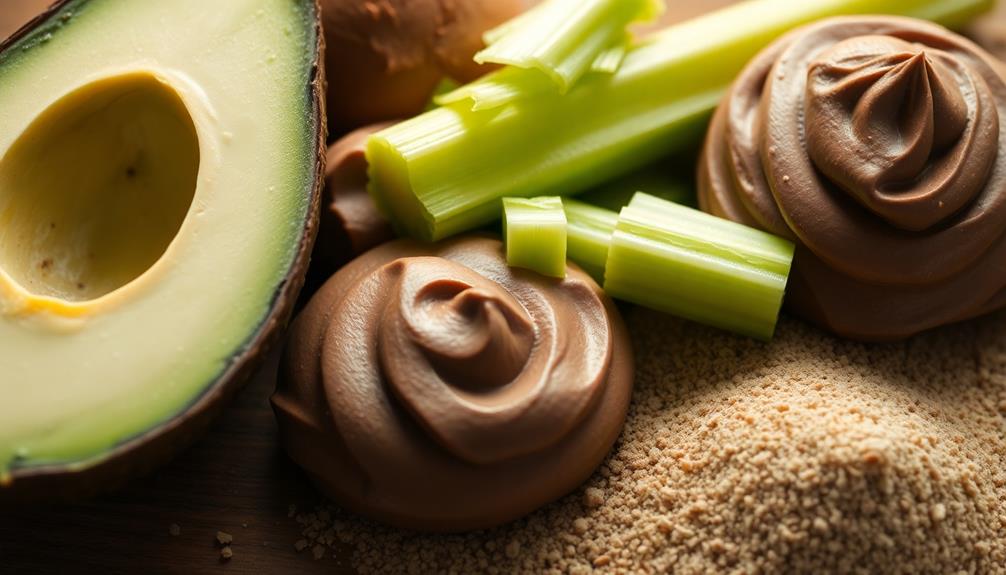
When you eat, the texture of food can trigger strong emotional responses and influence how you enjoy a meal.
For example, dishes like Chinese Steamed Egg offer a silky texture that can be comforting for some, while being off-putting to others.
If you have sensory processing issues, certain textures might overwhelm you, making it hard to embrace new foods.
Understanding how these factors shape your eating habits can help you navigate your culinary experiences better.
Sensory Processing Influences
Texture greatly shapes your culinary experiences, impacting how much you enjoy different foods. Your preferences are often influenced by sensory processing, which can lead to strong food aversions. For instance, if you have sensory processing disorder, certain textures might provoke negative reactions, making it hard to enjoy meals.
In Brazilian cuisine, the diverse textures found in dishes like Caldeirada and Caruru can provoke varied responses based on individual sensitivities.
Consider these common textures and their effects:
- Slimy – Foods like okra or certain fish can evoke immediate disgust.
- Crunchy – Crackers or fresh veggies often provide satisfaction and comfort.
- Gelatinous – Jell-o or pudding can be off-putting for many, triggering aversion.
- Chewy – Foods like gum or tough meats may test your patience and enjoyment.
Your cultural background and early exposure to various textures play a significant role in shaping these preferences. Those who experienced diverse foods as children are usually more open to trying new foods later on.
Curiously, your emotions can also influence your texture preferences; for example, when stressed, you might crave the satisfying crunch of chips as a coping mechanism. Understanding these sensory processing influences can help you navigate your culinary choices more mindfully.
Emotional Associations With Texture
Your relationship with food goes beyond taste; it's deeply intertwined with emotions, shaped considerably by the textures you encounter. Emotional associations with food textures can greatly influence your eating behaviors. For instance, negative past experiences, like choking on a particular food, may create lasting aversions to certain textures, such as slimy or gritty foods. These textures can evoke strong emotional responses, leading you to avoid them altogether during meals.
Individuals with sensory processing issues, particularly those with Autism Spectrum Disorder, often experience heightened reactions to food textures, which can complicate their relationship with eating. Understanding these emotional connections can help you navigate your food choices better.
Here's a quick look at how different textures can affect your emotions and eating behavior:
| Food Texture | Emotional Response |
|---|---|
| Slimy | Disgust, avoidance |
| Gritty | Discomfort, anxiety |
| Creamy | Comfort, pleasure |
| Crunchy | Joy, satisfaction |
Recognizing these emotional associations can empower you to make more informed dietary decisions, ultimately enhancing your overall dining experience. By understanding the emotions tied to certain foods, you can begin to identify patterns in your eating habits and make adjustments that align with your goals. For instance, you might notice a tendency to gravitate toward indulgent dishes during celebrations or opt for foods that signal social status in specific social settings. Acknowledging these influences allows you to strike a balance between enjoyment and nourishment, leading to a more mindful and satisfying relationship with food.
Factors Influencing Texture Preferences
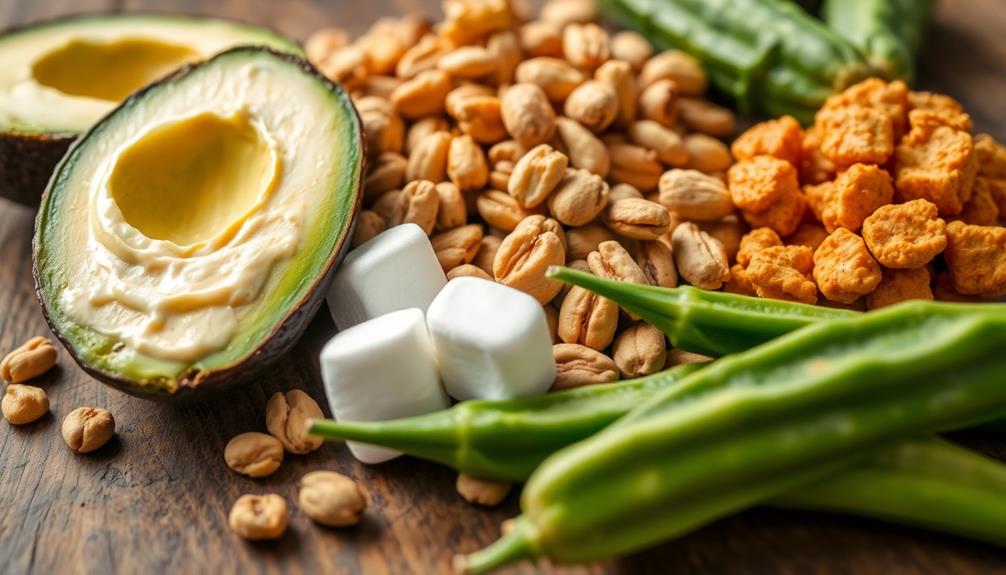
Food texture preferences are shaped by a variety of factors, including cultural backgrounds and early experiences. For instance, traditional dishes like Nasi Tumpeng can introduce individuals to unique textures that become comfort foods over time.
As you navigate your food choices, consider how these elements influence your likes and dislikes:
- Cultural Backgrounds: The textures you grew up with can set the tone for what you enjoy or avoid.
- Familiarity: If you're used to certain textures, you're more likely to embrace them when eating.
- Negative Experiences: A single unpleasant encounter with a specific texture can lead to lasting food aversion, shaping your preferences for years.
- Emotional States: Your mood matters! When stressed or anxious, you might gravitate towards textures that provide comfort, like creamy or crunchy foods.
These factors intertwine to create a complex web of texture preferences.
Your experiences, from the comforting crunch of a favorite snack to the squishy sensation of a disliked dish, are all part of this tapestry. Understanding these influences can help you navigate your own food aversions and find joy in a wider variety of textures.
Cultural and Emotional Influences
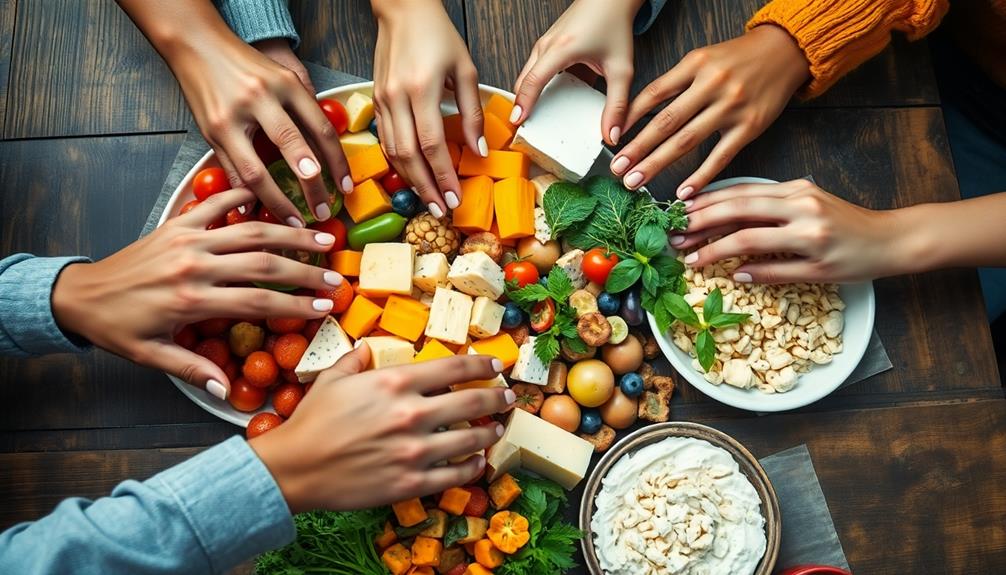
Your cultural background plays a huge role in shaping your texture preferences, as the foods you grow up with often become your comfort zone.
For example, Greek cuisine features unique textures, such as the rustic crunch of Horiatiko Psomi or the crispy delight of tomato fritters, which can evoke strong emotional ties.
Emotional connections to specific textures can also influence how you feel about trying new foods, whether positive or negative.
Understanding these influences can help you navigate your own food experiences more thoughtfully.
Cultural Context Impact
Cultural context shapes how you perceive food textures, influencing your preferences and aversions. Your cultural upbringing plays a significant role, as the textures you find appealing or off-putting can vary dramatically between environments.
For example, think about how:
- Crunchy vegetables like carrots might be a staple in your diet.
- Silky tofu could evoke memories of comforting family meals.
- Chewy seafood might trigger unpleasant experiences if you weren't exposed to it growing up.
- Creamy desserts may feel luxurious, thanks to positive associations.
Additionally, traditional dishes like Yetimatim Fitfit offer unique textures that reflect cultural heritage and can influence your perception of food.
Your family's dietary habits heavily influence your long-term food preferences. If you experienced a wide range of textures and flavors in your early years, you're likely more open to trying new foods. In contrast, limited exposure could lead to strong food aversions.
Additionally, the emotional experiences tied to specific textures can evoke powerful reactions. If a texture is connected to a negative memory, it may become unappealing.
Cultural narratives also dictate your perceptions of safety and desirability, shaping your willingness to embrace textures outside your norm. Understanding these factors can help you navigate your own food preferences and aversions.
Emotional Associations Matter
Emotional associations tied to food textures can shape your preferences in profound ways. If you've had negative past experiences with certain textures, it's likely that these memories contribute to your food aversions today. For instance, a slimy texture might remind you of an unpleasant experience, leading you to avoid similar foods entirely.
Additionally, the textures of foods such as Chilaquiles or Tamales can evoke strong emotional responses based on cultural familiarity.
Cultural backgrounds also play an essential role in molding your texture preferences. You may find yourself rejecting foods that don't align with what you're familiar with, like natto, despite its nutritional benefits. This rejection often stems from a lack of exposure to diverse flavors in your upbringing.
Additionally, the emotional impact of eating experiences can amplify your reactions to textures. If a particular food makes you feel joy, you might develop a fondness for its texture, while something that evokes disgust can lead to a lasting aversion.
Sharing food experiences within your community can enhance your understanding and acceptance of various textures. By engaging with different cultural narratives, you can expand your palate and perhaps even learn to appreciate textures you once disliked.
Managing Texture Aversions

Many individuals struggle with texture aversions that can make mealtime challenging. Exploring farm-to-table cooking can introduce fresh, vibrant ingredients that may enhance the sensory experience of meals.
However, there are effective strategies to manage these sensitivities and create a more enjoyable dining experience. Here are some approaches you can try:
- Gradual Exposure: Start with tiny tastes of foods you dislike. Over time, this can help desensitize your aversions.
- Food Preparation Methods: Experiment with different cooking techniques, like baking instead of boiling, to change the texture and make foods more appealing.
- Complementary Flavors: Pair aversive foods with flavors or textures you enjoy, enhancing overall meal satisfaction.
- Mindful Eating: Focus on the sensory experience of eating. Pay attention to flavors, aromas, and even the textures, which can help you manage your reactions.
If these strategies feel overwhelming, don't hesitate to seek professional guidance. Nutritionists or therapists can offer tailored support to help you navigate and overcome your texture aversions effectively.
With patience and practice, you can expand your palate and make mealtime a more enjoyable experience!
The Psychological Impact of Food Textures
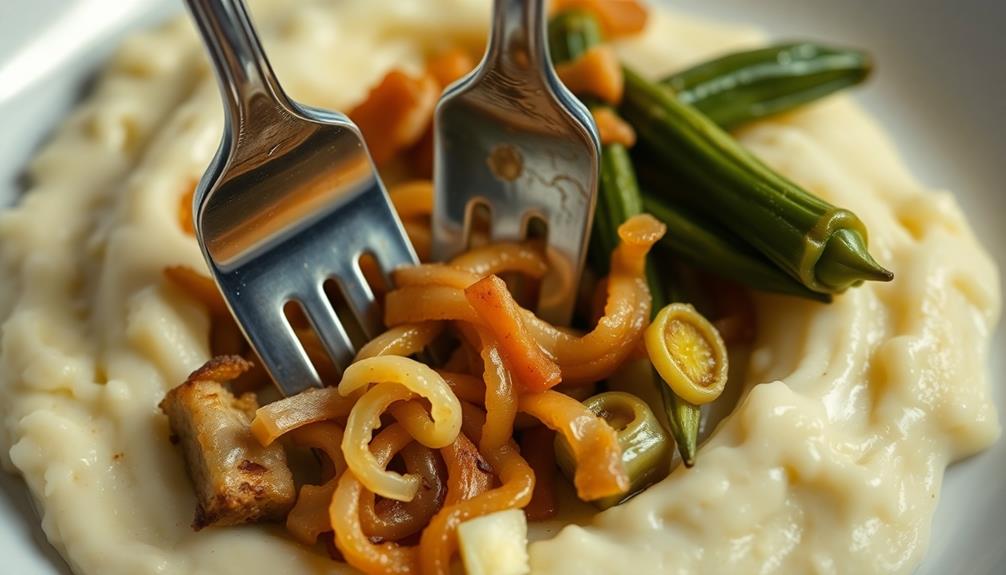
Food textures play an essential role in shaping your eating experience, often evoking strong emotional reactions that can influence your food choices. For instance, the creamy texture of a loaded baked potato might be comforting for some, while others may find it unappealing.
The psychological factors at play can't be underestimated; past negative experiences with certain food textures can lead to learned aversions. If you've had a distressing encounter with a slimy texture, your brain might now associate that sensation with discomfort, steering you clear of similar foods.
For individuals with sensory processing issues—common in conditions like ADHD and autism—these negative responses can be even more pronounced. You might find it incredibly challenging to tolerate certain textures, leading to an avoidance of specific foods altogether.
Your emotional states also contribute to this dynamic; when you're stressed, for example, you may become more sensitive to textures, amplifying your aversion or discomfort.
Social dynamics can further complicate your relationship with food textures. Peer pressure or shared experiences can either reinforce your aversions or encourage you to experiment with new textures.
Understanding these psychological impacts can help you navigate your food preferences and promote a healthier relationship with what you eat.
Frequently Asked Questions
Why Don't I Like the Texture of Certain Foods?
You might not like the texture of certain foods due to personal experiences or heightened sensitivity. Your upbringing, cultural influences, and unique interactions with food all shape your preferences, creating lasting impressions that affect your choices.
Why Are Some People Sensitive to Food Textures?
Like a finely tuned instrument, your senses react strongly to food textures. Sensitivity arises from sensory processing differences, emotional states, and early exposure, shaping your unique preferences. Understanding this can help you navigate your food experiences better.
What Is It Called When Someone Doesn T Like the Texture of Food?
When you don't like the texture of food, it's often called "texture aversion." This aversion can lead you to avoid certain foods, impacting your dietary choices and overall nutrition. Understanding it can help manage preferences.
What Foods People Don T Like Because of Texture?
You might notice that many people dislike foods like oysters, boba, or natto due to their unique textures. Conversely, crunchy items like crispy bacon or fries often appeal more to your taste buds.
Conclusion
To sum up, understanding your aversion to certain food textures can help you navigate your eating habits with more ease. Remember, "you can't judge a book by its cover"—the same goes for food! By recognizing the factors that influence your preferences, you can explore new flavors and textures that might surprise you. Embracing this journey not only enhances your meals but also enriches your overall dining experience. Don't shy away; give your taste buds a chance to grow!

